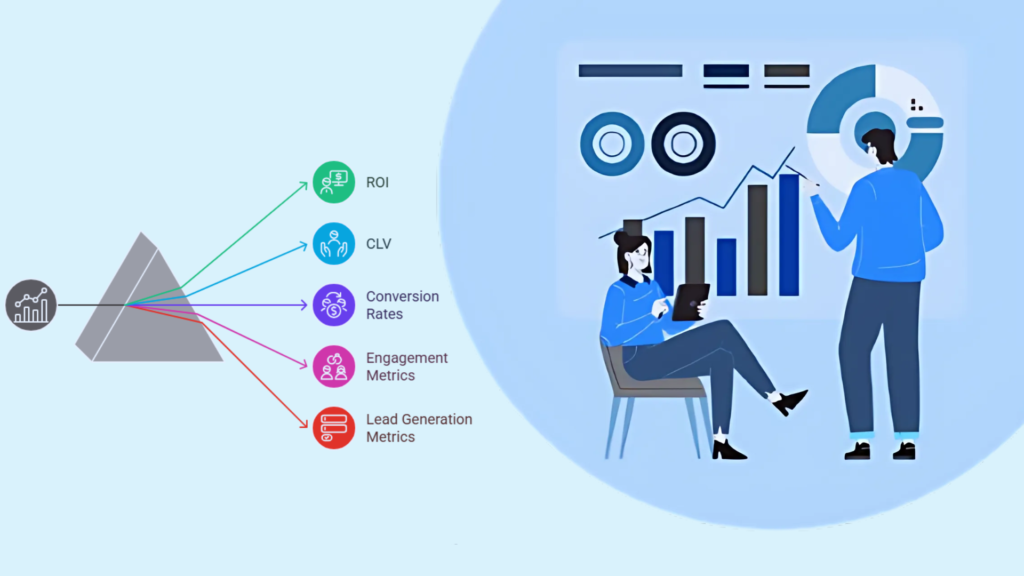Table of Contents
Toggle
Understanding the key marketing success metrics is crucial for optimizing strategies and maximizing ROI. Essential metrics include Return on Investment (ROI), measuring profitability; Customer Lifetime Value (CLV), predicting long-term customer value; Conversion Rates, reflecting prospect-to-customer conversion; Engagement Metrics, gauging audience interaction; and Lead Generation Metrics, assessing lead attraction and quality. These metrics provide data-driven insights for improved marketing success.
1. Return on Investment (ROI)
Why It Matters:
ROI remains the ultimate indicator of whether your marketing efforts are yielding profits. A precise ROI calculation helps determine if your marketing success spend is paying off or if resources should be reallocated elsewhere.
How to Calculate It
The formula for ROI is straightforward:
ROI= Revenue from Marketing−Marketing Costs/ Marketing Costs ×100
Why Track It
Tracking ROI offers immediate visibility into how effective a campaign is at converting marketing success spend into actual revenue. For startups and growing businesses, where every dollar counts, understanding ROI enables data-backed decisions that drive profitability.
Industry Application
For e-commerce brands, a high ROI means marketing spend is directly leading to sales. In B2B, ROI helps identify which channels are producing qualified leads that convert into long-term clients.
2. Customer Lifetime Value (CLV)
CLV measures the total worth a customer brings over the entire span of their relationship with your brand. This metric highlights the long-term impact of your marketing success strategies and indicates whether customer retention or acquisition should take priority.
How to Calculate It
CLV is often calculated as:
CLV=Average Purchase Value×Purchase Frequency×Customer Lifespan
Why Track It
Understanding CLV enables companies to invest smarter in customer acquisition while ensuring a steady flow of repeat business. For growth-stage startups, investing in retaining high-value customers often provides a higher return than constantly acquiring new ones.
Industry Application
For SaaS businesses, knowing CLV helps optimize subscription models and customer retention efforts. Retailers can adjust marketing success strategies to prioritize customers who are likely to make repeat purchases.
3. Conversion Rates
Why It Matters
Conversion rate is a direct reflection of how well your marketing efforts are turning prospects into actual customers. Whether the conversion is a sale, sign-up, or another goal, this metric is vital in evaluating campaign effectiveness.
How to Calculate It
The formula for conversion rate is:
Conversion Rate= Number of Conversions/ Total Leads or Visitors ×100
Why Track It
Tracking conversion rates allows marketers to fine-tune messaging, landing pages, or the overall user experience. For CMOs and marketers, low conversion rates often signal areas for immediate optimization.
Industry Application
E-commerce sites use conversion rates to measure the effectiveness of their checkout flow, while SaaS companies use it to evaluate how well their trial-to-subscription conversion process is functioning.
4. Engagement Metrics
Why It Matters
Engagement metrics are key to understanding how your audience interacts with your content. Whether it’s on social media, your website, or through email campaigns, engagement metrics show whether your audience is paying attention and taking action.
What to Track
Look at metrics such as:
- Social media engagement (likes, comments, shares)
- Click-through rates (CTR) for email campaigns and ads
- Website bounce rates
- Time on page
Why Track It
Tracking engagement helps you understand audience interest. A high level of engagement usually signals that your content is resonating well with your target market, which ultimately leads to better conversion rates and higher ROI.
Industry Application
For content-driven businesses, engagement metrics show which topics and formats connect most with the audience. For brands with large followings, engagement metrics often predict the effectiveness of future campaigns.
5. Lead Generation Metrics
Why It Matters
Lead generation metrics help businesses understand how effectively they are attracting and nurturing potential customers. Measuring these metrics reveals how successful your campaigns are at filling the top of the sales funnel with quality leads.
What to Track
Focus on:
- The number of leads generated through forms, sign-ups, or inquiries
- Lead quality and conversion rates from leads to paying customers
- Cost per lead (CPL)
Why Track It
For CMOs and marketing teams, knowing how well your lead generation strategies are working provides clarity on which channels and tactics to prioritize. For Series A startups, the ability to scale lead generation is often a critical factor in funding success.
Industry Application
In B2B sales, lead generation metrics are essential for identifying high-value prospects. In industries like real estate, these metrics help gauge the effectiveness of digital marketing strategies in attracting qualified buyers.
Conclusion
Marketing success isn’t just about running campaigns—it’s about running them with precision and understanding the performance indicators that matter. By consistently tracking and analyzing metrics like ROI, CLV, conversion rates, engagement metrics, and lead generation, you gain actionable insights that directly inform strategy, budget allocation, and long-term growth planning.
For those in leadership roles—whether as CMOs, seasoned marketers, or Series A startup founders—there’s an obvious takeaway: tracking these metrics is not just about measurement, but about refining and optimizing marketing efforts for maximum impact. With a keen eye on these metrics, you can refine your approach, maximize efficiency, and drive sustained growth.
Next Step: Start today by integrating these metrics into your marketing strategy. Leverage data to refine your campaigns and ensure you’re driving results that align with your business goals.
